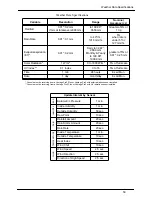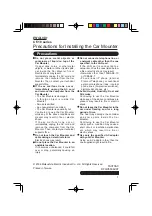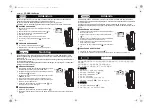
46
Barometric Pressure
Barometric Pressure
The weight of the air that makes up our atmosphere exerts a pressure on the surface
of the earth known as atmospheric pressure. Generally, the more air above an area,
the higher the atmospheric pressure. This means that atmospheric pressure changes
with altitude. For example, atmospheric pressure is greater at sea level than on a
mountaintop. To compensate for this difference and facilitate comparison between
locations with different altitudes, atmospheric pressure is adjusted to the equivalent
sea level pressure. This adjusted pressure is known as barometric pressure. In reality,
the Vantage Vue measures atmospheric pressure. When you enter your location’s
altitude in Setup Mode, the Vantage Vue stores the necessary offset value to
consistently translate atmospheric pressure into barometric pressure.
Barometric pressure also changes with local weather conditions, making barometric
pressure an extremely important and useful weather forecasting tool. High pressure
zones are generally associated with fair weather while low pressure zones are
generally associated with stormy weather. For forecasting purposes, however, the
value of the absolute barometric pressure is generally less important than the change
in barometric pressure. In general, rising pressure indicates improving weather
conditions while falling pressure indicates deteriorating weather conditions.
Evapotranspiration (ET)
Evapotranspiration (ET) is a measurement of the amount of water vapor returned to
the air in a given area. It combines the amount of water vapor returned through
evaporation (from wet surfaces) with the amount of water vapor returned through
transpiration (exhaling of moisture through plant stomata) to arrive at a total.
Effectively, ET is the opposite of rainfall, and it is expressed in the same units of
measure (inches, millimeters).
The Vantage Vue uses air temperature, relative humidity, barometric pressure,
average wind speed, and solar radiation data to estimate ET, which is calculated once
an hour on the hour. Measuring ET requires that the Vantage Vue console listen to a
an optional Vantage Pro2 Plus station with a solar radiation sensor installed.
Solar Radiation
What we call “current solar radiation” is technically known as Global Solar Radiation,
a measure of the intensity of the sun’s radiation reaching a horizontal surface. This
irradiance includes both the direct component from the sun and the reflected
component from the rest of the sky. The solar radiation reading gives a measure of the
amount of solar radiation hitting the solar radiation sensor at any given time,
expressed in Watts/sq. meter (W/m
2
). Measuring solar radiation requires that the
Vantage Vue console listen to an optional Vantage Pro2 Plus station with a solar
radiation sensor installed. Solar Radiation is displayed in the Weather Center when
ET is pressed and WxCEN is pressed multiple times.
UV (Ultra Violet) Radiation
Energy from the sun reaches the earth as visible, infrared, and ultraviolet (UV) rays.
Exposure to UV rays can cause numerous health problems, such as sunburn, skin
cancer, skin aging, cataracts, and immune system suppression. Measuring UV radia-
tion requires that the Vantage Vue console listen to an optional Vantage Pro2 Plus sta-
tion with a UV radiation sensor installed. The UV Index is displayed in the Weather
Center when ET is pressed and WxCEN is pressed multiple times.
Содержание Vantage VUE
Страница 1: ......







































